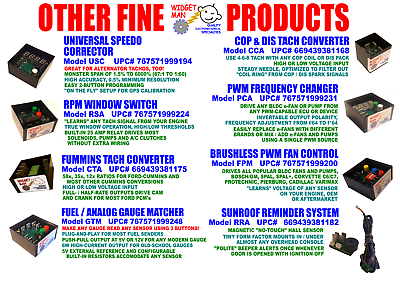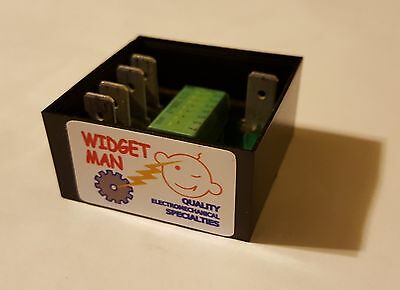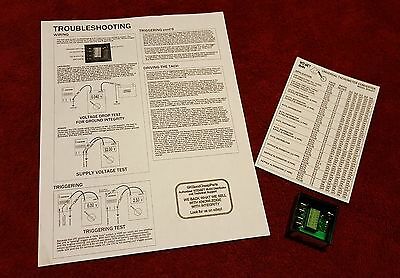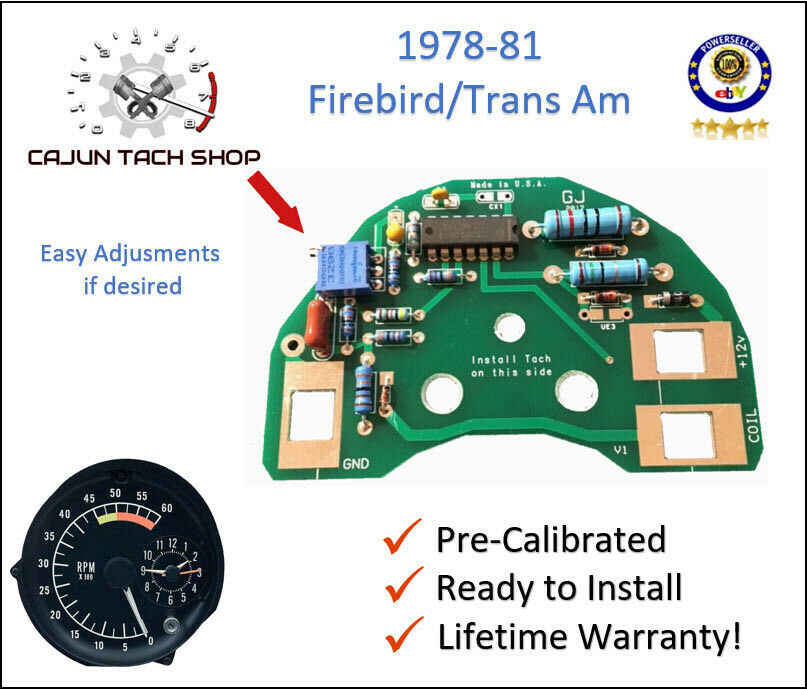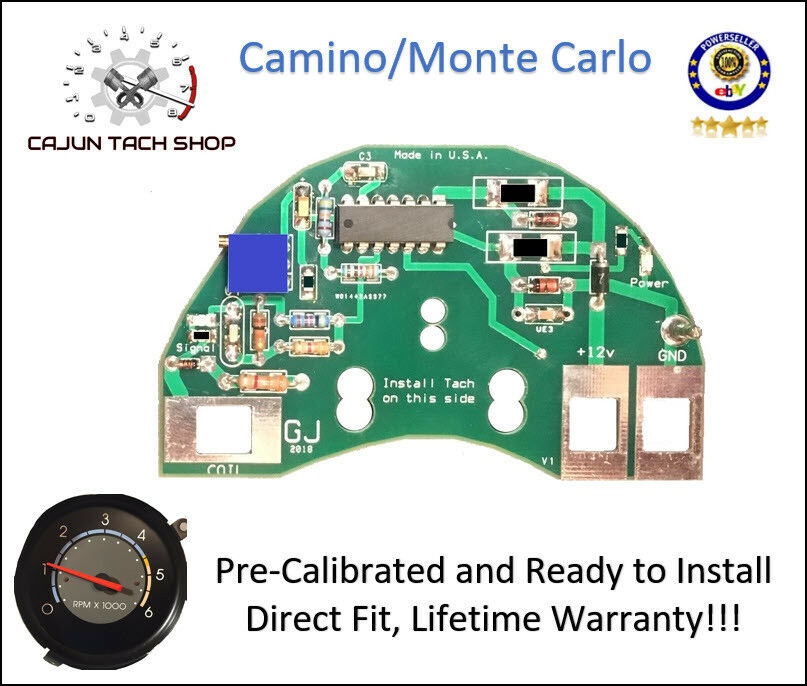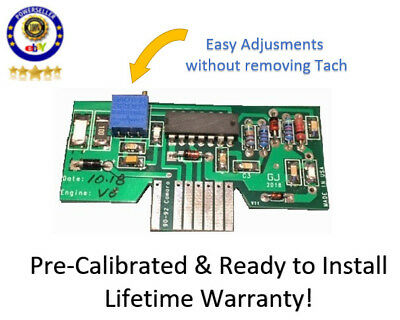-40%
UNIVERSAL TACH ADAPTER / CONVERTER, COP-1-2-3-4-5-6-8-10 cyl to any 4-6-8 Tach
$ 25.76
- Description
- Size Guide
Description
DOCUMENT DOWNLOADS AVAILABLE FOR THIS PRODUCTFAQ:
https://drive.google.com/file/d/1rEtIcIP-wDpxc1zwWm9F_XwoJsrTRCcI/view?usp=sharing
INSTRUCTIONS:
https://drive.google.com/file/d/1sjUW6cCsxLNg37lL2VkwUTE_dEarlEAW/view?usp=sharing
APPLICATION CARD:
https://drive.google.com/file/d/1nxjMPJEvoZk3G4OHt_tnI8ycxKhyVedX/view?usp=sharing
USING PULLUP RESISTORS:
https://drive.google.com/file/d/1QLjjXIbRG744A18xEpcQTxeahPeJVPEH/view?usp=sharing
WM CATALOG:
https://drive.google.com/file/d/1N_T1FOQnUAIDFX7IA6wUgK242Rak9SZ6/view?usp=sharing
ADD A TACH TO ALMOST ANYTHING!
WORKS WITH
SHIFT LIGHTS
NITROUS WINDOWS
2-SPEED FUEL PUMPS
TOO!
This sturdy device is perfectly comfortable living on top of a COP coil or on the bottom of a lawnmower. Simple switches program it for anything from screaming 2-strokes to monster V-10's, and it can use almost any input signal, even crankshaft sensors or home-cooked inductives. The number of pulses per revolution is all the info you'll need. It can drive standard tachs (voltage-pulse type) of almost any kind, even 5V OEM units. The hookup is 4 simple wires (power, ground, signal and output) using .25" fastons from any parts store. In most COP applications, 3 of the 4 wires can be tapped straight off the handiest coil, with the adaptor mounted right on top. The package comes with full instructions and easy-to-read labels. It also comes with
free email tech support
and a 90-day replace-or-refund warranty (don't smash it, of course, but we ask few other questions).
NEW - We now offer power supply noise filters (condensers) as a courtesy to our customers who may have noisy electrical systems (typically pre-1985 vehicles and most small-engine applications). Shipping is free (refunded) when purchased with any Widget Man adaptor or converter. See listing# 143562430919.
NEW: IF YOU'RE A PROFESSIONAL DOING FREQUENT ENGINE OR IGNITION SWAPS, THESE ADAPTORS ARE NOW AVAILABLE IN LOTS OF 5 AT SUBSTANTIAL SAVINGS! SEE OUR LISTING# 143420559859.
NEW!
FOR BELT-DRIVEN ALTERNATOR W, R, OR P TERMINALS, THIS ADAPTOR ISN'T THE RIGHT DEVICE. WE NOW HAVE A UNIVERSAL CORRECTOR THAT WILL HANDLE ANY PHASE AND PULLEY COMBINATION AND CAN BE PROGRAMMED "ON THE FLY". SEE OUR eBAY
LISTING#
14355479905
.
IF YOU PLAN TO USE THIS DEVICE ON A MOTORCYCLE OR OTHER VEHICLE WITH A SMALL ENGINE, PLEASE SEE MY LISTING
#
141979625888
UNDER
Motorcycle Parts > Gauges > Tachometers
FOR MORE INFORMATION.
What Buyers Have to Say...
So easy one wire hook up to coil. Perfect tach signal. Trying for weeks!!
- badabingone
Nitrous window signal, '08 Benz "Ferrari Eater"
Super satisfied... worked great. Was really impressed with how detailed the setup instructions were
- 4barkleys
Tach driver, '73 Datsun Pickup with supercharged GM 3.8L
The knowledge and expertise you guys have is amazing - rd7980dal
Tach dr
iver, Mokai motorized k
ayak with 7HP Robin-Subaru
My new PCM had no tach output (CAN system), so I was glad to find your adapter because I wanted to use the OE tach in the dash. Installation was easy - just had to flip an extra dip switch to get the tach speed right. Checked the RPM with a scan tool and it was spot on - jellyfish44
Tach driver, '91 Jeep Wrangler with 2009 4.7L V8
USE WITH LOW-VOLTAGE and DIGITAL SIGNALS (5v, 6V, 12V):
The UTC will work with trigger signals down to 4.1V, and can be used freely with digital or analog sensors at 12V or 5V. However, DIP-switch 7
must
be turned on for the UTC to "see" the signal.
The UTC will not trigger until about 25V with switch-7 in the off position.
USE WITH OEM TACH OUTPUTS:
The UTC will work with
any
OEM tach ouput, including GM HEI and Ford Duraspark-II systems. However, be aware that many OEM outputs (including HEI and DS-II) are actually internal connections to coil-negative, NOT 12V digital square waves like late-model ECU's. This means they produce very high voltages (up to 350V for some HEI's).
Since turning
switch-7 on disables most of the circuit protection inside the UTC, connecting to voltages above 15V can destroy the unit.
If in doubt, ALWAYS start with switch-7 in the OFF position. Switch it on only if the UTC fails to trigger.
FOR FORD COP-V8 and ALL OTHER COP OWNERS:
The UTC will work with
any
COP system, 2-wire or 3-wire. However, if you're considering the UTC as a low-cost alternative to the MSD 8913, Autometer 9117, or similar product, be aware that the
UTC does not work or wire the same way
. Those units work by sensing coil current instead of coil discharge, and they wire in series with the coil
power supply
, not the coil
trigger
. The UTC is not series-wired and senses trigger
voltage
. When wiring the UTC, some buyers have followed threads about the MSD unit on websites such as crownvic.net, but those threads do NOT apply to this product and should NOT be followed when installing one. For instance, on a V8 Vic or Grand Marquis, threads advise getting tach signal from the LG/R (light green with a red trace) wire to the coils. This is correct for the MSD, but it is the coil power wire and the UTC
cannot
get signal from it.
The UTC must be hooked to the
negative
side of
one
COP coil (i.e., to any of the individual trigger wires connecting each COP to the ECU). These can be easily identified because they will have a
different color wire for each coil
. The coil power lead (and ground lead on 3-wire COPs) will usually be the
same color on all coils
.
THE UTC WILL NOT WORK IF CONNECTED TO COIL-POSITIVE LIKE CURRENT-SENSING ADAPTORS.
IT MUST BE CONNECTED TO COIL-NEGATIVE OR A COIL TRIGGER WIRE.
FOR CDI IGNITIONS:
Most aftermarket CDI boxes like the MSD 6 and 6AL have a dedicated tach output, so the UTC can be be driven driven directly off that. For CDI setups that have no tach output, signal can be taken off the spark coil, but be aware that CDI's drive the coil from the
positive
side, not the negative like ordinary ignitions. You can easily identify a CDI by measuring voltage on the negative pin with the engine operating, if it stays near 0V at all times then the ignition is CDI. Swapping pins is usually all a CDI requires to work with the UTC, it can otherwise be treated like any other high-voltage source. Filtering isn't usually needed because CDI spark pulses are usually much shorter than normal ignitions, so "coil ring" is rarely an issue.
FOR 3-WIRE COP OWNERS ONLY:
Most 3-wire COP triggers produce no inductive "spike" like a coil-minus connection. Most are 12V square waves. For these systems, the UTC needs to operate with switch-7 on, just like connecting to a 12V sensor. However, the same caution applies as connecting to an OEM tach output
(see above)
:
Since turning
switch-7 on disables most of the circuit protection inside the UTC, connecting to voltages above 15V can destroy the unit.
If in doubt, ALWAYS start with switch-7 in the OFF position. Switch it on only if the UTC fails to trigger.
FOR DIS VEHICLE OWNERS:
Because the UTC senses trigger voltage, it cannot sense a DIS unit with no tach output in the same way as current-sensing units like the
MSD 8913 or Autometer 9117
. This is not a problem for externally-triggered DIS packs, because you can simply tap one of the trigger wires from the ECU, just like any COP system. The only complication compared to COP is determining the right ratio for your tach, since many DIS packs are essentially "dual fire" setups. This can be easily determined with a shop tach, simply changing the ratio switches until you find a setting that works. However, for self-contained DIS packs with an ECU onboard, you must find an alternative trigger source if there is no ECU tach output. Crankshaft sensors can be a good choice, provided you know the number of pulses per revolution and can calculate a ratio that works with your tach. However, many engines (like virtually all GM powerplants) produce too many pulses to be usable. Camshaft sensors can be used similarly and work very well on some vehicles--most GM LS motors have a 4-tooth cam ring that produces output similar to a 4-cyl distributor and is symmetric enough for a steady needle--but other engines with more asymmetric rings may produce a "wobbly" tach at low RPMs. This is something that only experiment will tell you. Alternatively, you can produce your own trigger by adding an aftermarket magnet/hall-sensor combo to your harmonic balancer (treat the output like a diesel with an external pickup) or an inductive clamp sensor on one of the spark plug wires (treat the output like COP). In most cases, the UTC will even trigger by wrapping a wire around a spark plug lead. The UTC is not fussy about signal level (any voltage from 4.1-200V will work), but it must see a change in
voltage
. If you have no suitable signal source, then the UTC will not work for you.
FOR POINTS-IGNITION OWNERS:
Points ignitions can be almost as "noisy" as magnetos, especially as the points age. Various spikes on the line can cause symptoms from double-triggering at low RPM to complete blanking at high RPM. For this reason, the UTC has a built-in RC (resistor-capacitor) filter that you can turn on with one of the DIP switches. The built-in value is 100K/0.1uF, but you can increase the filtering simply by adding one or more of the resistors included with the kit.
FOR MAGNETO IGNITION OWNERS:
The UTC has an RC filter for controlling noise (see POINTS above), but it also needs a DC power source to operate, as do all electric tachometers. If your vehicle has DC lights, a battery, or both, then you should be able to run the UTC and an electric tach off the electrical system. This includes most magneto-ignition motorcycles that have a headlight but no battery, since these generally have a low-voltage "lighting coil" built into the magneto that can be tapped for DC voltage. If your vehicle has AC lighting (like some snowmobiles) or no lights and no battery (like most motocross bikes and push lawnmowers), then it may not be possible to add a tach without also adding a DC conversion kit or other specialized hardware to provide a DC supply.
FOR ANTIQUE IGNITIONS:
The UTC will work with all 6V systems and with positive-ground systems. For positive-ground, simply reverse the power and ground pins on the UTC, connecting +V to ground and ground to +V. If your trigger is coil-negative, hook a 6V system up just like 12V and leave switch-7 off. However, if your trigger is a 6V level square wave from the system rail, you MUST use it with switch-7 ON.
FOR OWNERS OF 24V and "BACK-EMF" TYPE TACHOMETERS:
Many older tachs require greater than 12V to trigger, expecting to see the "spike" from a discharging ignition coil. Since the UTC outputs a 12V square wave, it can't drive these tachs without help. What is required is a "coil simulator" (aka "kicker coil") on the UTC output. This is just a high-voltage transistor connected to a small inductor like a relay coil. If you own one of these tachs, you can either purchase a weather-sealed kicker along with your UTC (see my EBay listing#
142171581596) or I can provide a schematic and parts list free of charge if you'd like to build one yourself
. If you aren't sure, tapping the tach trigger wire on the battery+ terminal will usually tell you -- if the needle jumps or quivers then 12V will probably trigger it, if not then you probably need a kicker.
FOR RVI AND OTHER CURRENT-SENSING TACH OWNERS:
Many antique English cars and other older makes used coil-coupled tachometers operating directly off the ignition points. Instead of voltage, these tachs sensed current flow through the points to ground, using the induced voltage to deflect the needle directly. Many snowmobiles also use current-mode tachs, driven off one leg of the magneto or lighting coil. The UTC can't drive this type of tach on its own, since it can output only milliamps of current (by contrast, a typical "toroidal" RVI needs an amp or more). However, in theory, the UTC should be able to drive a simple current amplifier (such as an N-FET or NPN power transistor) to provide enough current, essentially "pretending" to be the ignition points. One of my buyers planned to explore this on his re-motored MGB, but his RVI proved to be burnt-out. If you are good with solder and have an RVI or other current-mode tach that you would like to try driving with the UTC, I will offer a schematic, parts list, and continuing advice free on request.
NOTE: Units may come with clear potting (shown) or black. There is no functional difference and the shipped unit may be either color.


